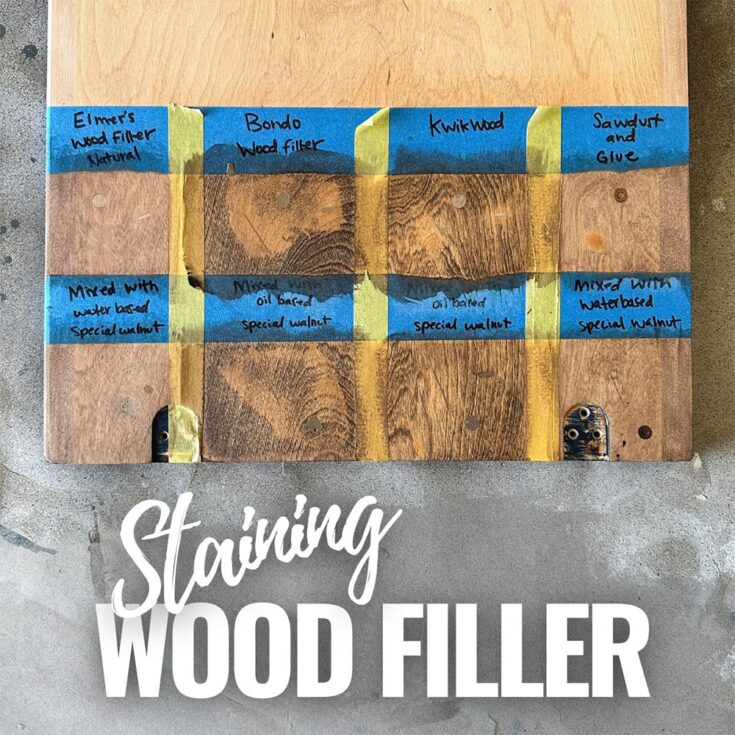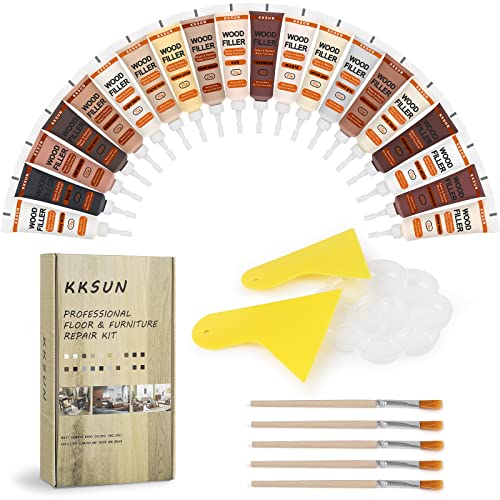Staining Wood Filler
Wood filler is a great solution for fixing minor damages or imperfections in wood furniture. However, the challenge comes in when staining wood filler, trying to blend the wood filler with the surrounding wood to make it look seamless.
The good news is that there are multiple ways to stain wood filler when refinishing furniture so that it matches the surrounding wood. In this blog post, we’ll look at four effective techniques for staining wood filler, so that you can restore your wood furniture to its former glory.

Before we dive into the techniques, it’s important to understand that wood filler is designed to fill gaps and imperfections in wood, but it’s not meant to replace the wood itself. Keep in mind that any stain or paint you apply to the wood filler will look slightly different from the surrounding wood.
The key is to minimize the difference as much as possible so that your repair is not noticeable.
So, let’s explore the different techniques for staining wood filler and choose the best one for your project.
Supplies used for staining wood filler
As an Amazon Associate, I earn from qualifying purchases. I also may earn from other qualifying purchases with other companies or get free product to review and use. All opinions are my own.
- Wood Stain Marker
- Gel Stain
- Bondo Wood Filler or KwikWood
- Chip Brush
- Water based Wood Filler
- Water based Stain
- Stain Repair Kit
- Wood Glue
Use a Wood Stain Marker
Using a wood stain marker is one of the simplest and quickest ways to stain wood filler.
Learn more about the Best Wood Fillers for Furniture here to know which one is right for your project.
It is especially useful for small spots that need touching up. Wood stain markers work like pens, making it easy to apply a stain directly to the filled area.
To use this method, allow the wood filler to dry completely and then sand it until it becomes smooth and flush with the surrounding wood.
Choose a stain that matches your wood and apply it over the wood filler. Allow it to dry completely. While this technique doesn’t completely blend the wood filler with the surrounding wood, it does help to reduce the appearance of the repair.
However, keep in mind that the wood filler may not exactly match the original stain color. For larger repairs or highly visible areas, other techniques may be necessary.
Apply Wood Stain To Dry Wood Filler
For this method, wait for the wood filler to dry completely, and sand the wood filler down so it is smooth and flush with the wood around it.
Apply a coat of wood stain over the wood filler, using a cloth or a brush. Choose a stain that matches the surrounding wood as closely as possible for the best results.
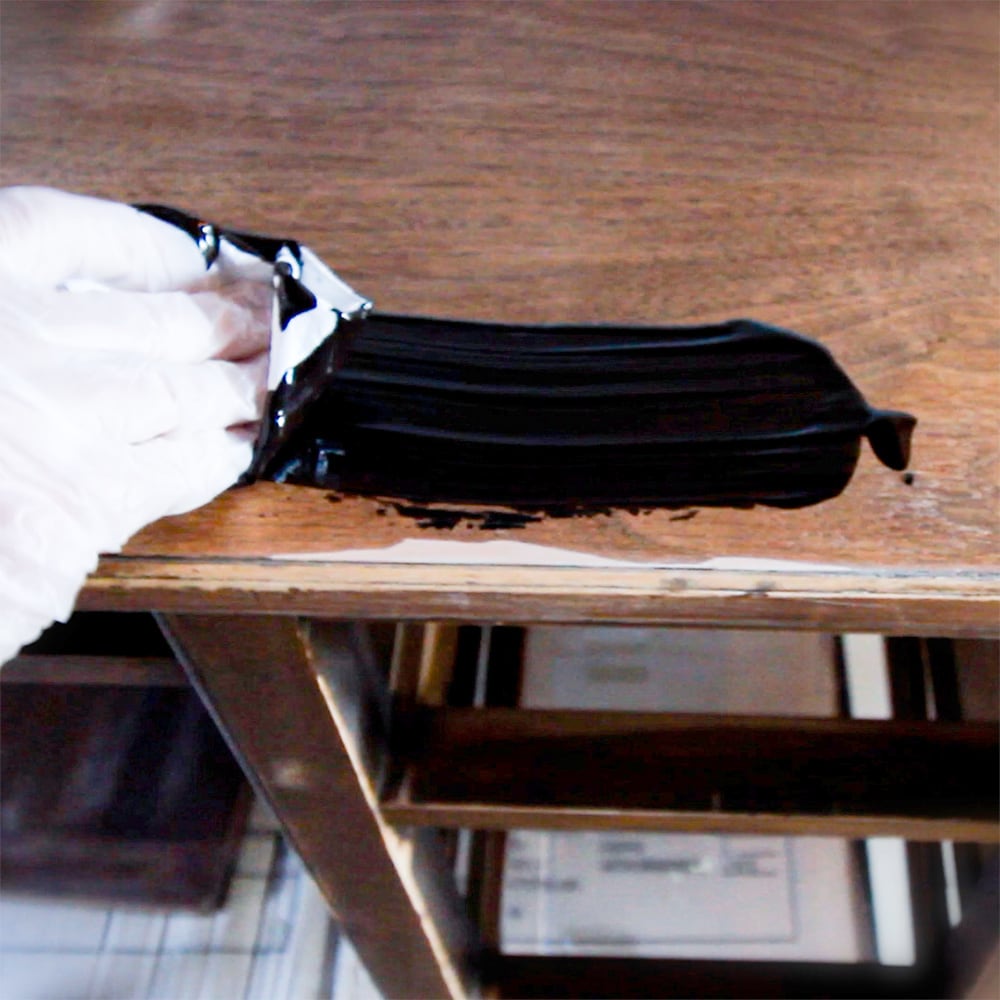
Check out this blog post about How to Repair (and Stain) Chipped Veneer Furniture to see one of the best ways to stain wood filler.
However, keep in mind that the wood filler may absorb the stain differently than the surrounding wood, resulting in a slightly different color. Applying a gel stain over the wood filler can help hide it more effectively than a traditional wood stain.
Gel stain has more body than regular liquid stain, so it doesn’t seep into the wood filler as much. Keep in mind that you may need to apply two or more coats to get the desired level of color and minimize the appearance of the wood filler.
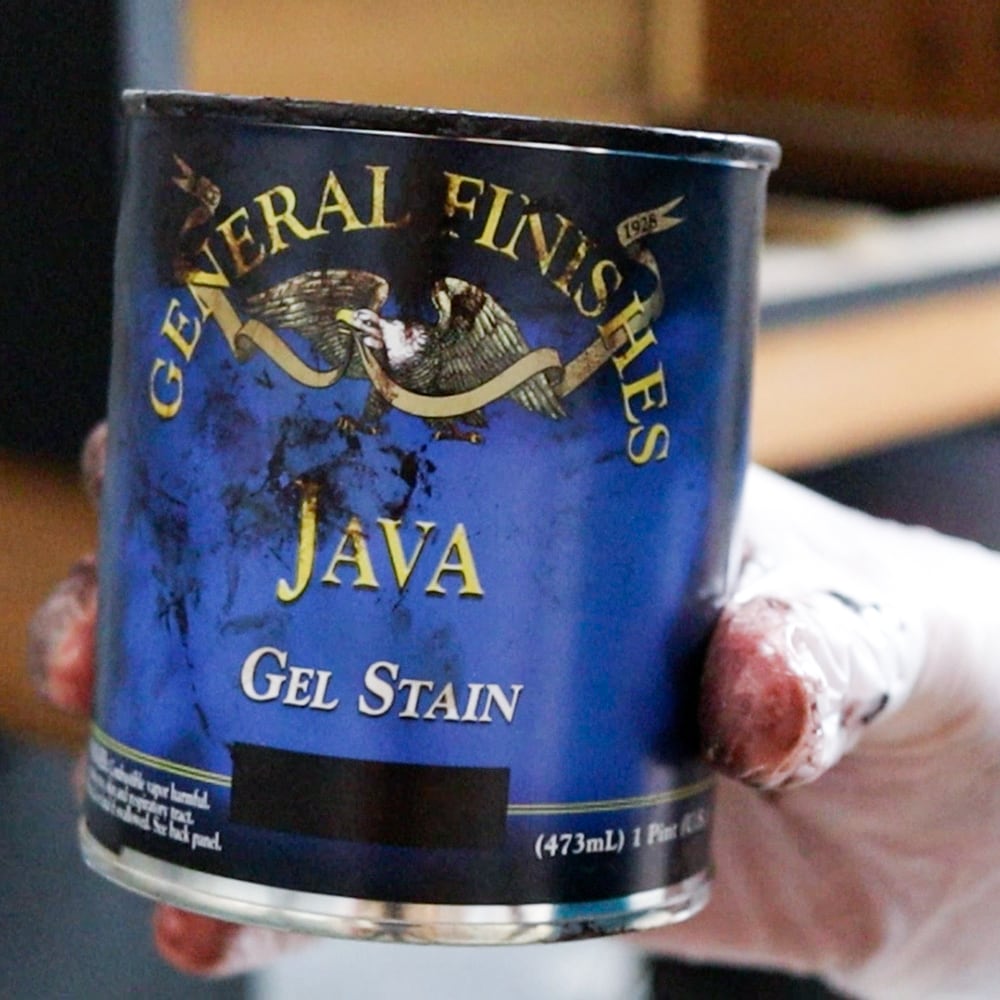
Check out The Farmhouse Cabinet Makeover post where we used gel stain on the outside of this cabinet.
This method isn’t as easy for small touchups and works best when you are refinishing all of the wood.
Mix Stain Into the Wood Filler
One effective way to blend wood filler with the surrounding wood is to mix the stain into the wood filler itself.
For this technique, mix a small amount of wood stain into Bondo Wood Filler or KwikWood types of wood fillers as you’re mixing the hardener and filler together.
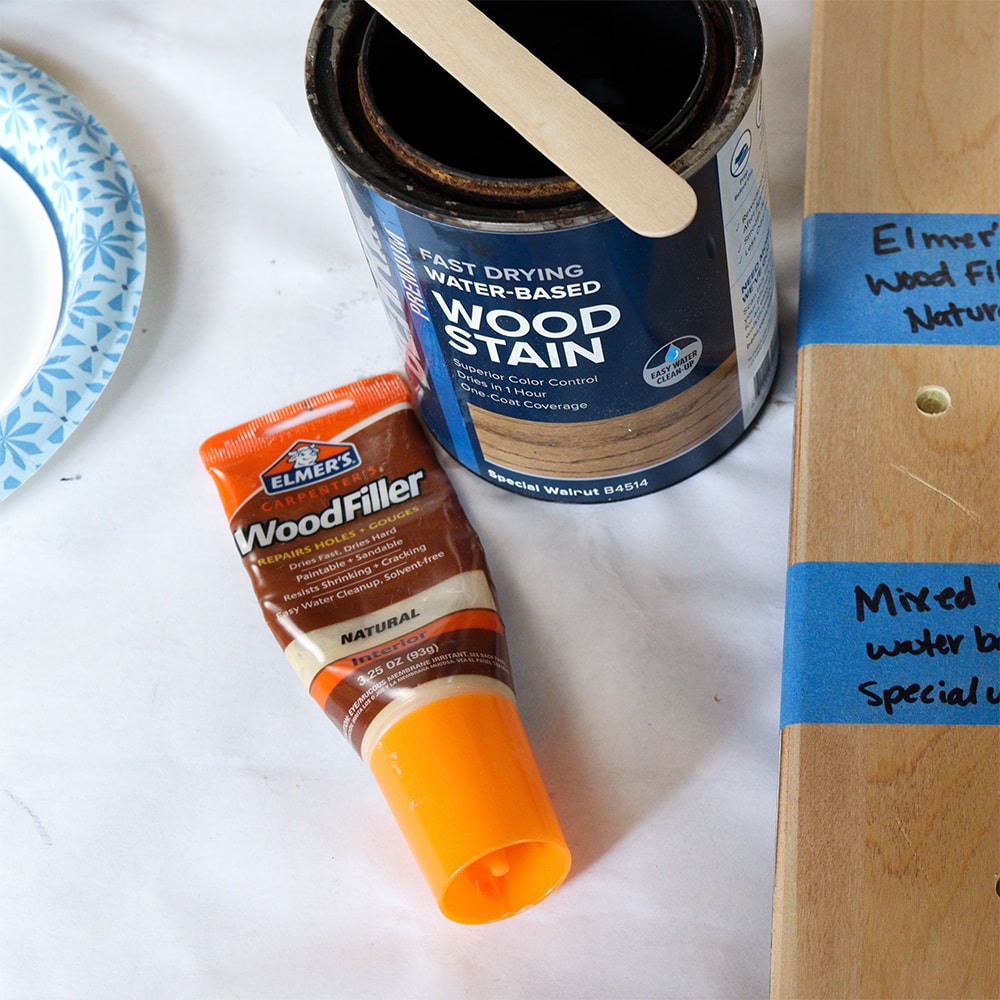
Learn how to use Bondo wood filler and KwikWood in these blog posts Repairing Veneer with Wood Filler and How to Use KwikWood.
Check out my Bondo wood filler review here to learn more.
This helps to change the color of the wood filler to match the color that you plan to stain the wood.
It’s important to test the coloring a few times before finally applying it to your project.
Be mindful to use a small amount of the stain to avoid making the wood filler too dark. Be aware that the wood filler will dry to a slightly different color as well.
Also, you can mix a water based wood filler and a water based stain as well.
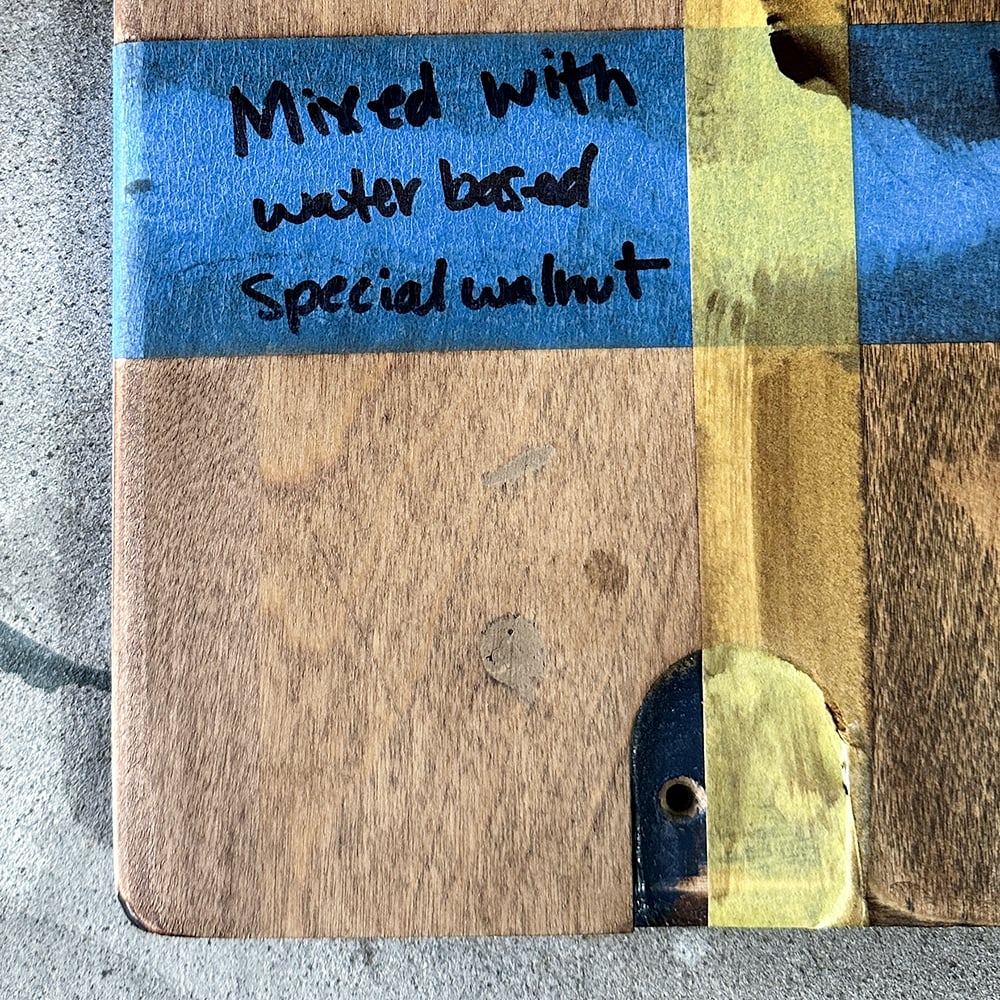
This mixing method works best when you are going to stain both the wood filler and the surrounding wood.
Use a Stain Repair Kit
A stain repair kit provides the best solution for restoring your wood furniture.
This specific repair kit comes with 20 different colors of resin repair compounds, so you can easily cover surface scratches and stains on any wood surface. This kit is suitable for both DIY enthusiasts and professional woodworkers.

The compounds can be EASILY mixed, layered, and blended to create a custom color that matches the surrounding stained wood, ensuring a seamless repair that is almost invisible.
Unlike other techniques, a stain repair kit doesn’t require staining the entire surface, so you can focus only on the repaired area. This Wood Repair Kit is the perfect solution for anyone looking to restore their wood furniture to its former glory.
Check out our wood stain repair blog post for more information on how this technique works!
Learn more about the other methods of wood surface repair and how to properly take care of your furniture to avoid scratches and blemishes on your furniture’s surface.
Get the Secrets!
Grab this super convenient How to Repair Furniture Ebook with all of our secrets on how to repair furniture for only $14.
You can print it out and have instant access whenever you come across damaged furniture, and know exactly how to fix it!
Click on the picture of the book to purchase!
DIY Wood Filler with Sawdust
If you’re looking for a low-cost way to fill small gaps or cracks in your wood project, try mixing sawdust and wood glue to create your own wood filler that matches your wood.

The process is simple. Sand your wood, then collect the sawdust from your sander’s dust collection bag, and mix it with a small amount of wood glue until it forms a thick paste.
The amount of wood glue you use depends on how much sawdust you have. Make sure that the sawdust and glue are mixed thoroughly to create a smooth paste that is easy to apply.
Apply the DIY wood filler, let it dry, and sand it smooth, just like with the other methods. This wood filler is much harder to sand than the other wood fillers though. I think the glue makes it stick super well, making it hard to sand.
Then you can stain it. It will still slightly differ from the stained wood, and the type of glue you mix in will be what changes the color of the wood filler the most.

Check out these Youtube videos Homemade Wood Filler with Sawdust and Wood Filler – Buy it or Make it? to see the DIY wood filler in action.
This technique works best when you are planning to stain all of the wood (because you have to sand it first!) or leave it in its natural color.
This method is cost-effective and can save you time and money on your project.
Can You Stain Wood Filler?
Yes, you can stain wood filler to match the surrounding wood. It’s essential to choose the right stain that matches the wood color, and some techniques work better than others.
Learn more about the Best Wood Stains for Refinishing Furniture here to get the best result for your project.
What’s the best way to stain wood filler?
The best way to stain wood filler depends on the size of the repair and the surrounding wood’s type and color.
Some common techniques include using a wood stain marker, applying stain to dry filler, mixing stain into the wood filler, using a stain repair kit, or mixing the sawdust with wood glue to create a wood filler.
Here are the results from a comparison test that we did.
Each section had a drilled hole, a deep gouge, and a light scratch. The waterbased wood fillers were mixed with waterbased wood stain, and the other wood fillers were mixed with oil based wood stain.
Which combination do you think hid the damage the best??
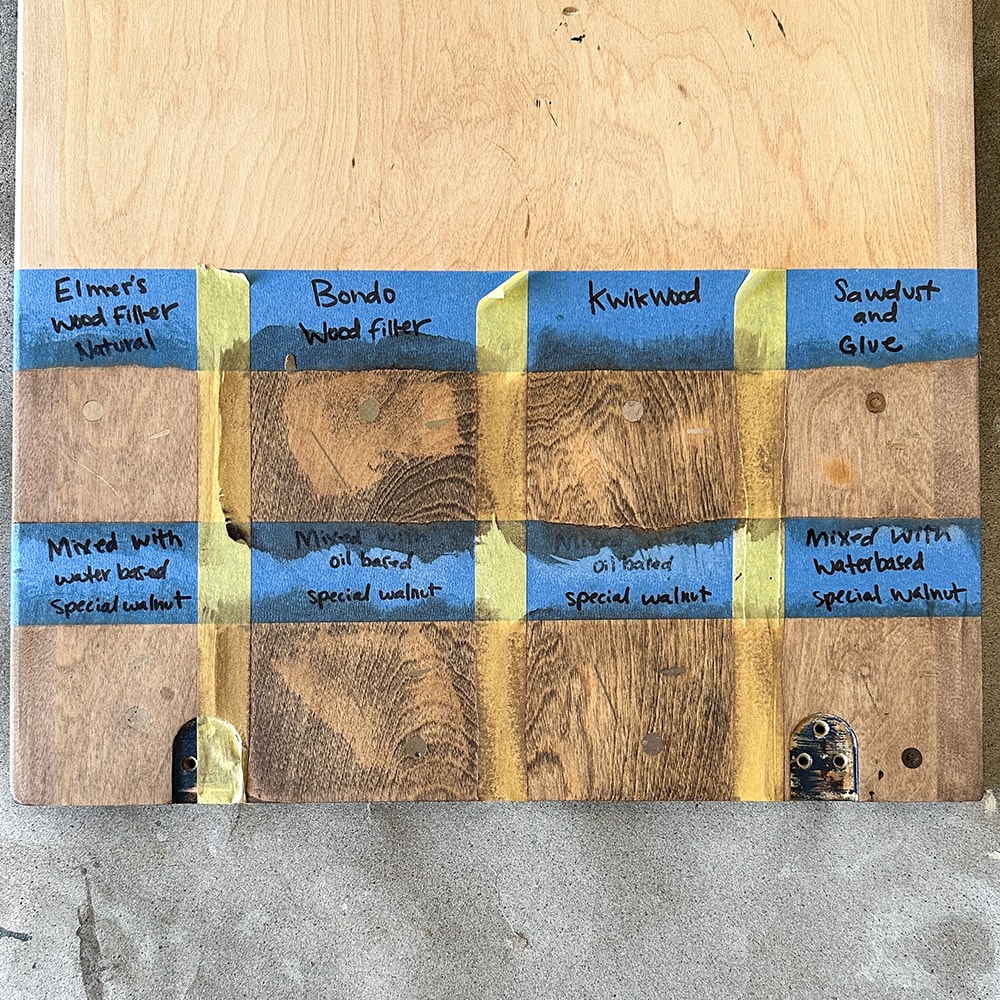
I think the Elmer’s wood filler mixed with water based wood stain blended in the best on this test.
Will wood filler soak up the stain like the wood surrounding it?
No, wood filler doesn’t soak up stain like wood. It can result in a slightly different color than the surrounding wood, so it’s essential to test your chosen technique on a small area before applying it to the whole project.
How do I choose the right stain for my wood filler?
Choosing the right stain for your wood filler involves matching it with the surrounding wood’s type and color. Samples and swatches can help you identify the best match.
It’s important to have patience throughout the process and experiment until you find the perfect color match.
Overall, staining wood filler can be a challenging task, primarily if you’re looking for it to match the surrounding wood color perfectly.
However, choosing the right technique and following the instructions for each method can help you achieve an almost invisible repair.
Check out the Best Brushes For Staining Wood here that will perfectly fit your needs.
Whether it’s using a wood stain marker, applying a gel stain over the dry filler, mixing stain with your wood filler, or using a stain repair kit, selecting the right approach for your project can make all the difference.
By experimenting and having patience, you can restore and repair your wood furniture, and have it looking as if it were brand new.
With these techniques, you can now begin your DIY project and make the wood filler blend effortlessly with your wood.
More Wood Staining Tips and Ideas
- How to Stain Wood Darker
- How to Restain Wood Furniture
- Staining a Dresser Darker
- How To Stain Wood With Paint
- How to Stain Already Stained Wood
Follow us on YouTube to get more tips for painting furniture.
Or share your project with us on our Facebook Group and be part of our community. See you there!


